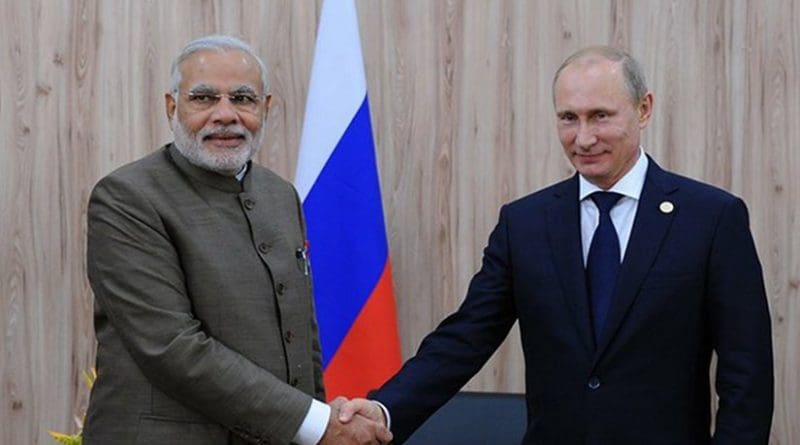Managing Moscow – Analysis
By Observer Research Foundation
By Pushan Das
As New Delhi situates itself in Asia’s unsteady power dynamic, its key imperatives remain closing the ever increasing military capability gap vis-à-vis China and Pakistan, and strengthening its ability to be a net security provider in the immediate region. The recent defence deals between India and Russia may be an indicator of the armed forces’ modernisation drive. But they are also reflective of India’s faltering efforts towards indigenisation, and its continued dependence on Russian military platforms. Maintaining its strategic tilt toward the United States while also having its concerns about Russia-Pakistan military engagement heard in Moscow will be an immense diplomatic challenge for India, especially considering its military dependence upon Russia.
Although officially non-aligned, India leaned more toward the Soviet Union during the Cold War and relied on it for military equipment. The legacy of this decision has resulted in more than 70% of Indian military hardware, from jet fighters to submarines, being of Russian origin. However, it is interesting to note that, despite robust numbers in absolute terms, Russia’s share of India’s defence procurement has fallen as ties between India and the United States have burgeoned in recent years. For example, in 2014, the United States surpassed Russia in arms exports to India for the first time, with $1.9 billion in exports. In contrast, the United States had exported only $237 million in arms to India in 2009.
Though strategic autonomy is one motivation for India’s diversification from Russian weapons, another important consideration is the unreliability, delayed logistics support, and delivery delays of Russian platforms. For example, the Russia-supplied Sukhoi-30MKI, the main stay of the Indian Air Force, has a low availability rate of 55%, which means only slightly more than half the fleet is available for operations at anytime. Similarly, the Indian Navy’s aircraft carrier borne Mig-29K (another Russian platform) has a fleet availability rate of only 37%. In stark contrast, the recently signed deal with France for 36 Dassault Rafale aircraft guarantees a minimum 75% fleet availability rate. Furthermore, the Indian Army has in the past faced delays in receiving the transfer of technology from Russia for the T-90, its main battle tank, and its ammunition.
However, budgetary constraints have meant that the Indian armed forces have not been able to quickly invest in technologically advanced platforms to leapfrog their war fighting capabilities. Thus, in the short and medium term, India must continue to have a robust defence relationship with Russia, especially considering contracts already in place, needed assistance with logistical issues and spare components, and the necessity of modernising existing weapons platforms. In addition, the inability of Indian defence public sector companies to even deliver basic military platforms like light utility helicopters on time implies that India will continue to rely upon Russia for new platforms as well. For example, India and Russia will enter into a joint venture to produce 200 Kamov 226 light helicopters.
As India struggles to close the widening military gap in the region, managing or curtailing Russian military exports to Pakistan gains importance, in order to prevent any substantive military advantage in favor of Pakistan. In August 2015, Pakistan purchased four Mi-35M attack helicopters from Russia’s state arms exporter Rosoboron export. While this sale is not significant in absolute military terms, it does open the possibility for the further sale of more advanced weaponry in the future. Furthermore, it is significant that Pakistan has decided to continue relying upon the Russian RD-93 engine for its JF-17 fighter, jointly developed by China and Pakistan, as opposed to switching to a Chinese engine. Russia has further strengthened its defense ties with Pakistan by allowing it to buy the RD-93 engine directly from Russia, as opposed to using China as an intermediary, as was the case previously.
As I have argued elsewhere, Russia has three primary motives to improve ties with Pakistan. First, Russia seeks to respond to the improving Indo-US defense relationship. Although India remains the largest importer of Russian military equipment, it could serve Russia well to diversify with new buyers, for an industry suffering from international sanctions. Second, it seeks to cooperate with Islamabad to crackdown on Islamic terrorism in areas of mutual interest like Afghanistan and Central Asia. Third, post-Crimea, Russia has aligned itself more closely with China and thus, closer to the China-Pakistan axis.
Progress on several big ticket military items like the Kamov 226 light helicopter under Make in India, the S-400 surface to air missiles systems, four frigates, and the lease of a second Akula-class nuclear submarine between Moscow and New Delhi over the past few days have arrested the perception of a downward slide in their strategic relationship in the short to medium term. India’s long-term challenge, however, will be to diversify its military procurement and maintain its improved relationship with the United States without losing Russian support for its key objectives, especially regarding Pakistan. India can already see how difficult of a challenge this is through its failure to garner explicit Russian support for labeling Pakistan as a state sponsor of terrorism at the recent BRICS summit declaration. As long as India remains militarily dependent upon Russia, it will have to consider Moscow’s interests.
*This article originally appeared in South Asian Voices.

